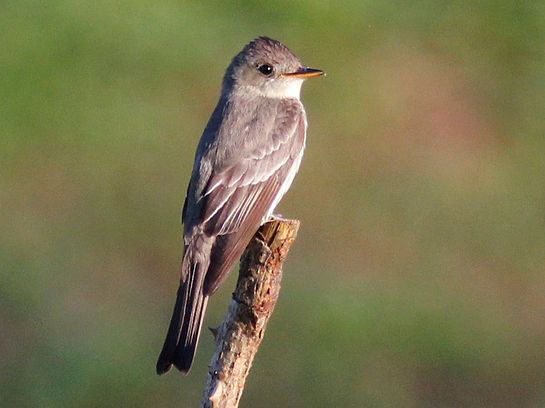Information About The Bird
Seen/Heard at
Decorah North
Diet
Eastern Wood-Pewees are flycatchers. They capture insects in air, “hawking” to catch and eat flies, bugs, butterflies, moths, bees, wasps, beetles, grasshoppers, crickets, stoneflies, and mayflies. The pewee also eats small amounts of vegetable matter, including the berries and seeds of dogwood, blueberry, and poison ivy.
Eastern Wood-Peewees are very similar to Eastern Kingbirds in diet, preferred habitat, appearance, and lifestyle. Both birds are Tyrant Flycatchers. You can meet more of the family here: https://bit.ly/2yv1Ukl
Nesting
Eastern Kingbirds breed from mid May through late September. Males and females choose the nest site, but the female builds the nest. She begins by building a foundation from coarser materials, including weeds, bark strips, twigs, roots, mosses, pine needles, leaves, fur, and hair. She rotates as she builds the nest, pressing it down with her tail and shaping it as she goes. The inner cup is lined with fine hair, grass, moss, lichens, and plant fibers, and the nest is camouflaged with lichens. Eastern Wood-Peewees lay two to four creamy white eggs splotched with brown and purple speckles around the large end. They produce one clutch a year. Females incubate eggs for 12-16 days and both parents tend young, which leave the nest 16-18 days after hatching. To learn more, visit Cornell’s website.
Citations
Bird Range Maps of North America
Ridgely, R.S., T.F. Allnutt, T. Brooks, D.K. McNicol, D.W. Mehlman, B.E. Young, and J.R. Zook. 2003.
Digital Distribution Maps of the Birds of the Western Hemisphere, version 1.0. NatureServe, Arlington, Virginia, USA. Data provided by NatureServe in collaboration with Robert Ridgely, James Zook, The Nature Conservancy – Migratory Bird Program, Conservation International – CABS, World Wildlife Fund – US, and Environment Canada – WILDSPACE.
Web Link: http://bit.ly/2ynPQ5I
Birds of North America: https://birdsna.org/Species-Account/bna/species/eawpew/introduction
[/two_thirds]
[third class=”field_third”]
General Description
Eastern Wood-Peewees have grey to olive grey overparts with underparts that grade from dark at the sides of the breast to pale on the throat. The pale color continues down the upper belly as a streak and typically widens out on the lower belly, giving the pee-wee a vested appearance. Adults have two thin white wingbars and their lower mandibles are usually yellow-orange.
Migration
Eastern Wood-Peewees migrate from Decorah to South America, wintering in Venezuela, Columbia, Ecuador, Peru, and Bolivia east into the western Amazon basin.
Measurements
Length: 5.9 in/15 cm
Weight: 0.3-0.7 oz/10-19 g
Wingspan: 9.1-10.2 in/23-26 cm
Wing Design
Elliptical. Optimized for bursts of fast, tightly controlled flight. Excellent at taking off quickly, maneuvering through branches, and avoiding predators.
[/third]
[/full]
| See also different: | Decorah Nest, Tyrant Flycatchers |
